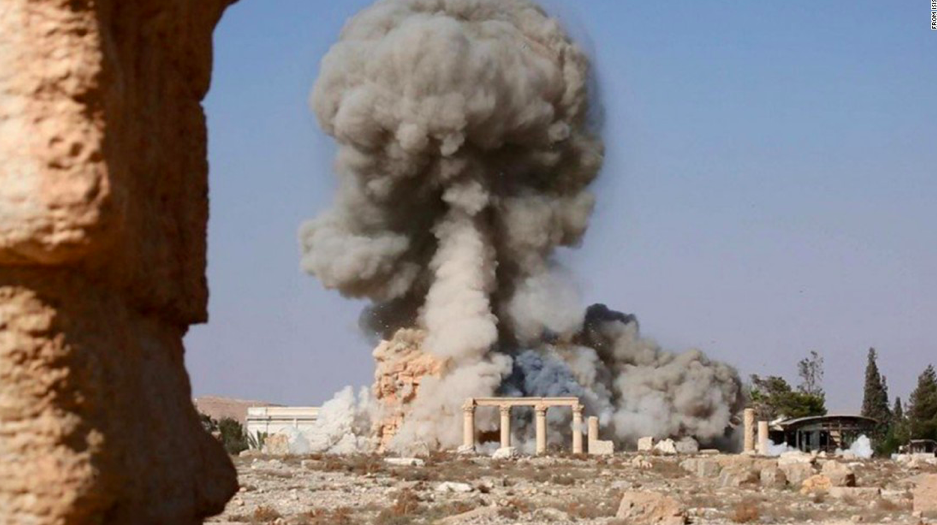
Image courtesy of: http://bit.ly/227Yrx8
This week’s ouster of so-called Islamic State (ISIS) forces from the Syrian city of Palmyra sparked cautious optimism from some observers. Aside from the destruction of the city’s ancient ruins, Palmyra appeared less damaged than had been originally feared after its takeover by the Islamic State. Yet under the surface of this reclaimed land lies a nasty truth about the terrorist group’s long-term impact. The ancient ruins and surrounding areas are laced with mines and improvised explosive devices (IEDs), planted by ISIS fighters intent on denying the Syrian Army any momentum in its advance.
This is not a new tactic. A year ago, when Iranian-backed militias pushed ISIS out of the Iraqi city of Tikrit, they found their offensive stalled by thousands of explosives hidden in the ground. In Ramadi, where Iraqi Army forces have been largely successful in driving out ISIS occupiers, mines and IEDs have become one of the greatest dangers to advancing ground forces. Resettlement efforts in both cities have been slowed significantly due to the persistent threat of hidden explosives. In countless, smaller retreats, ISIS has been brutally proficient in its emplacement of explosive devices to thwart government forces in their drive to reclaim lost territory.
Mine warfare in Iraq and Syria has proven disruptive to military units and civilians alike. Absent a concerted, technically demanding effort to uproot hidden explosives, mine emplacements can effectively deny large areas for years. Aside from the clear human rights implications, this tactic carries grave consequences for basic security and the provision of government services in formerly occupied territories. The loss of freedom of movement, as civilians and government forces shy away from unseen dangers, can have a dramatic effect on citizens’ confidence in representative officials and undermine government legitimacy.
The NATO experience in Afghanistan serves as a useful historical analogy with regard to the impact of mines and explosives. In some parts of that country, especially in heavily contested Helmand and Kandahar Provinces, Taliban-allied fighters created ad hoc minefields out of IEDs. Their goal was to deny government access to key terrain in order to preserve the primacy of their shadow government in the eyes of a victimized population. The tactic largely worked, as NATO and Afghan government forces adopted cumbersome preventive measures or avoided mined areas altogether. Unable or unwilling to penetrate the improvised belts of explosives surrounding key areas, NATO and Afghan forces could never reliably access or fully gain the confidence of certain populations. Not coincidentally, some of the most densely mined parts of the country were also the first to fall to Taliban control upon the departure of NATO combat forces.
ISIS forces appear to have adopted a similar plan for dealing with the temporary military superiority of Iraqi and Syrian forces. Where ISIS fighters face a numerical disadvantage and cannot stand and fight, they prefer to deny territory to the victors. The Afghan analogy suggests that their goals may be three-fold. First, ISIS hopes that such explosives might delay the attacking forces long enough to allow ISIS to effectively consolidate and eventually counterattack. Failing that, ISIS gains a significant boost to its propaganda of intimidation and omnipresence with every government soldier killed by a well laid mine. Finally, mines may prevent the effective provision of government services for long enough to allow ISIS forces to capitalize on the ensuing tensions and loss of confidence in government by those civilians living in contested areas.
Initial reports from Palmyra suggest that Russian engineers may aid the Syrian Army in mine detection and removal. Despite outside help, the process will likely prolong the effort to advance and consolidate gains in ISIS territory. Given the extent and density of the minefields being reported, it may take months for life to resume a semblance of normalcy in Palmyra. In this sense, despite losing its hold on the city itself, ISIS may reassert its presence far longer than anticipated.
This pattern—first Tikrit, then Ramadi, and now Palmyra have been laced with mines in anticipation of defeat—holds grave implications for the likely next steps in the war against ISIS. An offensive for Mosul has stalled, but retaking Iraq’s second largest city is an absolute necessity to pushing ISIS from the country. Heavy urban fighting is quite likely, but if pushed out of the city, ISIS will almost certainly employ mines. Given the size and density of Mosul—a city of 2.5 million before it fell to ISIS—the de-mining process could take many months and severely hamper attempts at establishing effective governance in a city that has been in extremists’ hands for almost two years. It is almost unfathomable that the Iraqi military could undertake such an endeavor without direct assistance.
Beyond Mosul, Raqqa and Deir al-Zour are the Islamic State’s remaining urban strongholds, both located in Syria. As forces backed by Russia, Iran, and the West slowly close in on ISIS, and as the group becomes more desperate, the intensity of its tactics will likely increase. Starting with Mosul, we should expect to see its scorched earth campaign intensify, increasing the time and effort required to retake each successive piece of territory. Momentum is a key factor in most wars, and may indeed hasten the end of the Islamic State’s reign over parts of Syria and Iraq. Yet in the midst of celebrations over the recapture of Palmyra, it is worth reflecting on the possibility that the road ahead may only become more difficult, and more strewn with hidden explosives, for advancing government forces.
